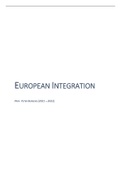Resume
Samenvatting EI
- Cours
- European Integration
- Établissement
- Universiteit Antwerpen (UA)
Samenvatting van het boek 'Politics In The European Union' en de ppt's van de prof. Met deze samenvatting behaalde ik een 14/20 bij het schriftelijk examen.
[Montrer plus]




